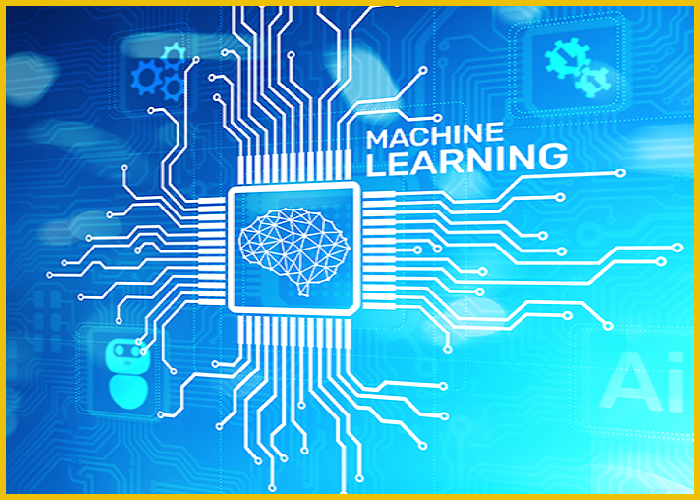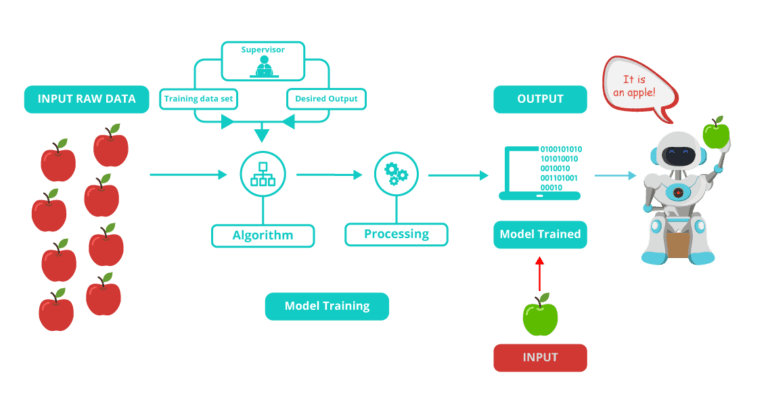What Is Machine Learning (ML)?

Machine learning (ML) stands out as a powerful tool that enables computers to learn from data and make decisions without explicit programming. From personalized recommendations on streaming platforms to autonomous vehicles navigating city streets, machine learning algorithms are transforming industries and shaping the future of technology.
Defining Machine Learning
Machine learning is a subset of AI that focuses on developing algorithms and statistical models that allow computers to perform tasks without being explicitly programmed. The core principle behind ML is to enable systems to learn from data, recognize patterns, and make decisions or predictions based on that data.
How Machine Learning Works
Data Collection: Machine learning algorithms require vast amounts of data to learn from. This data can include images, text, numerical data, or any other type of structured or unstructured information relevant to the task at hand.
Training: During the training phase, the algorithm is exposed to labeled examples from the data. These examples consist of input data (features) and the corresponding correct output (label or target). The algorithm learns to recognize patterns and relationships between the input data and the output labels.
Learning Patterns: The algorithm uses statistical techniques to identify patterns and make predictions or decisions based on new, unseen data. This ability to generalize from the training data is what distinguishes machine learning from traditional rule-based programming.

Types of Machine Learning
Machine learning can be categorized into several types based on the learning approach and the nature of the data:
Supervised Learning: In supervised learning, the algorithm learns from labeled data, making predictions or classifications based on known outcomes. Common applications include spam detection, image recognition, and medical diagnosis.
Unsupervised Learning: Unsupervised learning involves training algorithms on unlabeled data to identify patterns and structures within the data. Clustering algorithms, anomaly detection, and recommendation systems are examples of unsupervised learning applications.
Reinforcement Learning: Reinforcement learning involves training agents to make sequences of decisions in an environment to maximize cumulative rewards. This approach is used in robotics, gaming, and autonomous systems.
Applications of Machine Learning
Machine learning finds applications across various domains, including:
Natural Language Processing (NLP): Understanding and generating human language, used in virtual assistants like Siri and language translation services.
Healthcare: Diagnosing diseases from medical images, predicting patient outcomes, and personalized medicine based on genetic data.
Finance: Fraud detection, algorithmic trading, credit scoring, and risk assessment based on transaction data and market trends.
Automotive: Autonomous driving, where machine learning algorithms analyze sensor data to make real-time driving decisions.

Learning machine learning (ML) can be an exciting journey, but it requires dedication, practice, and a structured approach. Here’s a step-by-step guide to help you get started and progress in your machine learning journey:
1. Understand the Basics of Machine Learning
-
Conceptual Foundations: Start with understanding what machine learning is, its types (supervised, unsupervised, reinforcement learning), and common algorithms (linear regression, decision trees, neural networks).
-
Mathematics and Statistics: Refresh or learn key concepts like linear algebra, calculus, probability, and statistics, which form the foundation of machine learning algorithms.
2. Learn Programming Languages and Libraries
-
Python: Python is widely used in the machine learning community due to its simplicity and the availability of powerful libraries such as NumPy, Pandas, and Scikit-learn. Learn Python basics and how to manipulate data with libraries.
-
R: Another popular language for statistical computing and graphics, especially in academia and research.
3. Explore Machine Learning Algorithms
-
Start with Simple Algorithms: Begin with simpler algorithms like linear regression and logistic regression to grasp fundamental concepts such as model training, evaluation, and prediction.
-
Progress to Complex Algorithms: Explore decision trees, random forests, support vector machines (SVM), and deep learning models like neural networks as you gain confidence.
4. Hands-On Projects and Practice
-
Kaggle Competitions: Participate in Kaggle competitions or other online platforms to apply your skills to real-world problems and learn from the community.
-
Build Personal Projects: Create your own projects, such as predicting housing prices based on historical data or classifying images using deep learning, to deepen your understanding and showcase your skills.
5. Study Machine Learning Libraries and Frameworks
-
Scikit-learn: Explore Scikit-learn for a wide range of classical machine learning algorithms and tools for data preprocessing and model evaluation.
-
TensorFlow and PyTorch: Dive into deep learning frameworks like TensorFlow and PyTorch for building and training neural networks, especially for complex tasks like image recognition and natural language processing.
6. Stay Updated with Industry Trends and Research
-
Read Research Papers: Follow research conferences (e.g., NeurIPS, ICML) and read papers to stay updated on the latest advancements in machine learning techniques and applications.
-
Online Courses and Tutorials: Enroll in online courses like Coursera’s Machine Learning by Andrew Ng or Fast.ai for practical deep learning applications.
7. Join Communities and Seek Mentorship
-
Online Forums: Engage with communities on platforms like Reddit (r/MachineLearning), Stack Overflow, and LinkedIn to ask questions, share insights, and learn from others’ experiences.
-
Find a Mentor: Seek guidance from professionals or experienced practitioners in the field who can provide mentorship and advice on advancing your machine learning skills.
8. Practice Ethical Considerations
- Ethical AI: Understand the ethical implications of machine learning, including biases in data, fairness in algorithms, and responsible deployment of AI systems.
9. Build a Portfolio and Network
-
GitHub: Showcase your projects and code on GitHub or similar platforms to demonstrate your skills to potential employers or collaborators.
-
Networking: Attend meetups, conferences, and workshops to network with professionals in the industry and stay informed about job opportunities and trends.
10. Continuous Learning and Improvement
-
Stay Curious: Machine learning is a rapidly evolving field, so maintain a curious mindset and be open to learning new techniques, algorithms, and technologies.
-
Practice Regularly: Consistent practice and application of machine learning concepts and algorithms will solidify your understanding and improve your proficiency over time.
By following these steps and staying committed to learning and practicing, you can develop a strong foundation in machine learning and embark on a rewarding career path in this exciting field of artificial intelligence.

Knowing machine learning opens up a wide range of opportunities and enables you to engage in various impactful activities across different fields. Here are some key things you can do with machine learning skills:
1. Solve Complex Problems
-
Predictive Analytics: Use machine learning algorithms to forecast trends, make predictions, and derive insights from data in fields such as finance, healthcare, and marketing.
-
Pattern Recognition: Develop algorithms to recognize patterns in data, such as identifying fraudulent transactions, detecting anomalies in medical images, or predicting customer behavior.
2. Automate Processes
-
Automation: Implement machine learning models to automate repetitive tasks and processes, improving efficiency and reducing human error in tasks like data entry, customer support, and manufacturing.
-
Robotics and Autonomous Systems: Develop algorithms for robots and autonomous systems to navigate environments, make decisions, and perform complex tasks without constant human intervention.
3. Enhance User Experience
-
Personalization: Use machine learning to personalize user experiences, such as recommending products on e-commerce platforms, suggesting content on streaming services, or customizing healthcare treatments.
-
Natural Language Processing: Develop chatbots and virtual assistants capable of understanding and responding to human language, enhancing customer service and user interaction.
4. Advance Scientific Research
-
Drug Discovery and Genomics: Apply machine learning to analyze genetic data and identify potential drug candidates, accelerating the discovery of new treatments and therapies in healthcare.
-
Climate Modeling and Environmental Science: Use machine learning to analyze climate data, predict environmental changes, and develop strategies for sustainability and conservation.
5. Create Innovative Products and Services
-
Image and Speech Recognition: Develop applications that can recognize and interpret images, videos, and speech, enabling advancements in fields like security, entertainment, and accessibility.
-
Autonomous Vehicles: Contribute to the development of self-driving cars and drones by designing algorithms for perception, decision-making, and navigation.
6. Business Intelligence and Decision-Making
-
Data-driven Insights: Use machine learning to extract meaningful insights from large datasets, enabling informed decision-making and strategic planning across organizations.
-
Risk Assessment and Fraud Detection: Develop models to assess risks, detect fraud, and enhance security measures in industries such as banking, insurance, and cybersecurity.
7. Contribute to AI Research and Development
-
Innovate: Explore cutting-edge research in areas like deep learning, reinforcement learning, and generative models to push the boundaries of AI capabilities and develop new technologies.
-
Open Source Contributions: Contribute to open-source machine learning projects and collaborate with the global community to advance the field and make AI accessible to all.
8. Entrepreneurship and Innovation
-
Startups: Launch your own startup leveraging machine learning to solve specific industry challenges or create disruptive technologies that address market needs.
-
Consulting and Freelancing: Offer machine learning expertise as a consultant or freelancer, helping businesses implement AI solutions and optimize their operations.
Learning machine learning (ML) offers numerous compelling reasons, reflecting its transformative impact across various domains. Here are some key motivations for why learning machine learning is beneficial:
1. Unlocking Career Opportunities
-
High Demand: ML skills are in high demand across industries such as technology, healthcare, finance, and retail, offering numerous job opportunities and career growth.
-
Lucrative Salaries: ML professionals command competitive salaries due to their specialized skills in data analysis, predictive modeling, and AI development.
2. Driving Innovation and Technology Advancements
-
AI-Powered Solutions: ML enables the development of AI-powered applications that automate tasks, enhance decision-making, and innovate product development.
-
Advanced Technologies: ML drives advancements in fields like autonomous vehicles, robotics, natural language processing, and personalized medicine.
3. Solving Complex Problems
-
Data Insights: ML allows businesses to extract valuable insights from large datasets, improving operational efficiency, customer satisfaction, and strategic planning.
-
Predictive Analytics: ML models predict trends, customer behavior, and market dynamics, helping businesses stay competitive and agile.
4. Personal and Professional Development
-
Continuous Learning: ML fosters a culture of continuous learning and skill enhancement, keeping professionals abreast of cutting-edge technologies and industry trends.
-
Problem-Solving Skills: ML teaches critical thinking, problem-solving, and data-driven decision-making skills that are applicable across various domains.
5. Contributing to Societal Impact
-
Healthcare Advancements: ML aids in medical diagnosis, drug discovery, personalized treatment plans, and disease prediction, improving healthcare outcomes.
-
Environmental Conservation: ML supports climate modeling, biodiversity conservation, and sustainable resource management efforts.
6. Meeting Future Challenges
-
Emerging Technologies: ML prepares individuals and organizations to harness the potential of emerging technologies like quantum computing, IoT, and blockchain.
-
Ethical AI Development: Learning ML encourages responsible AI development practices, addressing concerns related to bias, privacy, and algorithmic transparency.
Conclusion
Learning machine learning is not just about acquiring technical skills but also about preparing for a future where data-driven insights and AI-driven solutions will be central to innovation and problem-solving. Whether you’re passionate about advancing technology, making a societal impact, or securing a rewarding career, mastering machine learning equips you with the tools and knowledge to thrive in an increasingly digital and interconnected world.



Post Comment